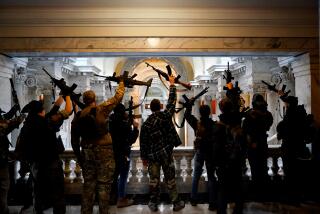Analysis: When it comes to guns, the Parkland shooting survivors aren’t here to play nice
Since the shooting massacre at Marjory Stoneman Douglas High School last week, a student there named Sarah Chadwick has amassed a Twitter following of more than 150,000 people. On Thursday night, Chadwick decided to share a thought with them.
Was it time for a message calling for thoughts, prayers and privacy?
Hardly. It was time to dunk on one of Florida’s U.S. senators for taking donations from the National Rifle Assn.
“We should change the names of AR-15s to ‘Marco Rubio’ because they are so easy to buy,” Chadwick wrote, earning 45,000 retweets.
This is what politicizing a tragedy looks like, and the kids are more than happy to keep doing it.
With 17 of their classmates and faculty shot to death, the students of the school have become celebrity activists, whom many left-leaning Americans have embraced as the new leaders of the nation’s gun control movement.
The students have been bold, confrontational and even abrasive, rarely holding back their anger, even if it means disrespecting their older, establishment opponents. They say what they mean.
“Honestly, just using brutal honesty — that’s it,” said student David Hogg, one of the movement’s most prominent voices. “I know people are saying it’s intense. I would argue the opposite. We’re fighting for these kids that died because they can’t fight anymore. We’re really trying to get justice for them.”
Hogg added: “Everybody deals with grief in a different way. For me, it’s anger, and wanting to prevent whatever caused it from happening again.”
The students’ stridency has added pressure on lawmakers and kept the shooting from fading from the headlines.
It has also insulted the feelings of right-wing adversaries at several points, including by implying gun rights supporters have the 17 deaths at Stoneman Douglas on their hands.
“Sen. Rubio, it’s hard to look at you and not look down a barrel of an AR-15 and not look at [suspected shooter] Nikolas Cruz,” student activist Cameron Kasky told Rubio at CNN’s Wednesday night town hall with students, parents and lawmakers. The remark drew scorn on the right.
“No thanks, Cameron,” a writer at the conservative website RedState.com fired back at the student later. “I don’t need some 17-year-old putz to defend my kids. In fact, either of my daughters, particularly the 13-year-old, can kick your ass. And when it comes to choosing sides, I’m on the other.”
The students have also faced accusations of being, well, disrespectful brats.
“Parents, what would you do if your child lectured and ridiculed a U.S. senator on national television?” Fox News personality Todd Starnes tweeted after Kasky and other students ripped into Rubio.
The kids know exactly what they’re doing, and they don’t care about the criticism.
“When these politicians kill our friends, why are we expected to play nice?” Hogg said. “Obviously it’s due to their inaction; that’s what we’re aiming at.”
Hogg’s own prominence has led to a backlash of conspiracy theories accusing him of not being a student at the school. It also led him to question who, exactly, has been lowering the discourse.
“You know what’s disrespectful?” Hogg asked. “Calling out witnesses to a mass shooting and calling us actors. That’s disrespectful. And even questioning whether we were even … there.… We are teenagers … we’re not known for being mature, but c’mon.”
The students’ advocacy has also been expressed in the language of their generation, which is well-versed in the combative “dunks,” “burns” and “owns” of arguing on social media. They know how to speak into their own cameras, they know how to play to audiences online, and so when a fight breaks out on social media, it’s on their turf.
Fellow student Chadwick’s AR-15 zinger about Rubio drew the scorn of Fox News host Laura Ingraham, who, on her own Twitter account, called out the “sophomore” by name to flag concern over “HOW TEENS SPEAK TO AND ABT ADULTS.”
Chadwick, suddenly identified for misbehavior by one of the most powerful figures in conservative media, responded drolly with three words that earned 15,000 retweets: “I’m a junior.”
While the movement has inspired students at schools around the nation to perform walkouts in support of gun control, the history of 21st century activism has shown that there are upsides and downsides to organizing over social media.
Platforms such as Twitter excel at helping newfound activists to create and document conflict, and to attract ever-larger audiences for their own messages. Their visibility also helps recruit like-minded peers outside of their own communities.
But over the long term, social media platforms can also pose a risk to activist movements by magnifying and publicizing disputes between members or creating bitterness among core supporters who play key roles but who attract less public attention.
So far, few signs of internal dissent seem to have broken out among Stoneman Douglas students, whose cohesion has struck longtime advocates as unique.
“I don’t think we’ve ever seen an entire community, including the survivors, have a clear call to action,” said Shannon Watts, founder of Moms Demand Action, a gun control group.
In past mass shootings, it has been common for family members of victims to become passionate, outspoken gun control advocates.
But in Parkland, “it’s as if all of them agreed immediately that stronger gun laws would prevent anyone else from going through this tragedy again,” Watts said. “These teens are realizing they don’t have to live this way, they don’t have to die this way.”
The students’ stridency, however disliked by their opponents, seems to have had an effect on Republican lawmakers. President Trump and Florida Gov. Rick Scott, who are strongly supported by the NRA, have signaled that they are open to raising the age limit for buying weapons.
Grilled by students, Rubio declined to say he would stop accepting donations by the NRA, but he said he would be open to banning large ammo magazines or supporting other legislation.
Rubio also learned firsthand the risks of talking to a radical younger generation that has been unfamiliar with the past failures of the gun control movement, including the inability to bring back the nation’s assault-weapons ban.
“Once you start looking at how easy it is to get around it, you would literally have to ban every semiautomatic rifle that’s sold in the U.S.,” Rubio said at the town hall with students and parents.
Rubio was implying that such a move would, politically, go way too far.
What Rubio did not anticipate is that the audience of students would start applauding at the idea.
“Fair enough,” Rubio said. “Fair enough. That is a valid position to hold.”
But he added the political reality that students will face as they prod federal and state lawmakers around the country: “My colleagues do not support banning every semiautomatic rifle sold in America.”
Matt Pearce is a national reporter for The Times. Follow him on Twitter at @mattdpearce.
More to Read
Sign up for Essential California
The most important California stories and recommendations in your inbox every morning.
You may occasionally receive promotional content from the Los Angeles Times.











